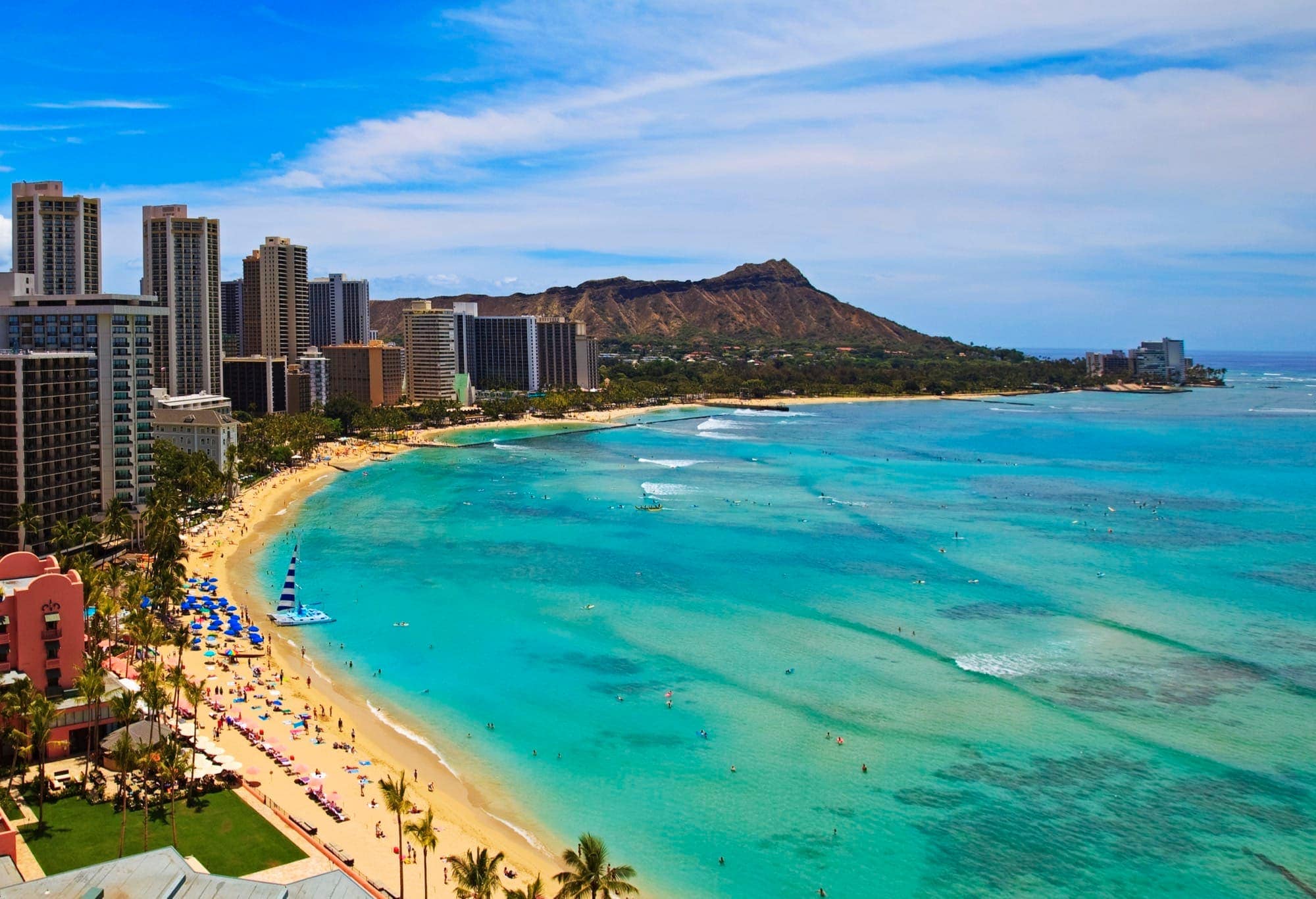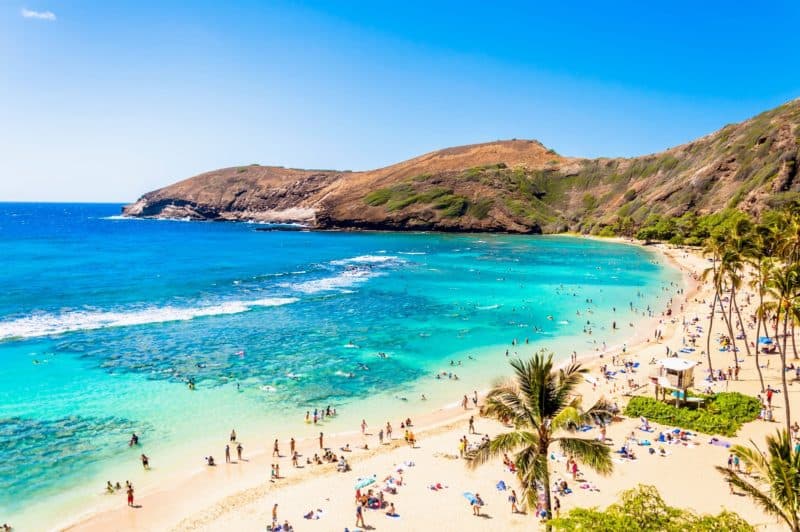When planning a trip to Hawaiʻi, the most-asked questions we receive are: Which islands should I visit? Or, which island is better?
To help people make this determination, we’ve published a variety of comparison guides that highlight key differences between the islands and provide recommendations based on popular activities, whether it’s bumming on the beach or hitting the trails.
Table of contents
- Oahu essentials: Things to know before choosing Oʻahu
- Getting there, getting around, and island hopping
- Where to stay
- How many days is enough?
- The most popular activities and attractions
- 5 visitor tips to guide your visit
Table of Contents
- Oahu essentials: Things to know before choosing Oʻahu
- Getting there, getting around, and island hopping
- Where to stay
- How many days is enough?
- The most popular activities and attractions
- 5 visitor tips to guide your visit
Great trips are properly planned, and pre-trip knowledge of the islands is essential. To help, we’ve created this “beginner series” that highlights everything you need to know before visiting each island.
Read on for an overview of Oʻahu, or check out our beginner’s guide to the Big Island here.
Things to Know Before Choosing Oʻahu
The island of Oʻahu is much different than the neighbor islands like Maui, Kauaʻi, and Big Island. Before you decide to visit, you should understand how it’s different and what to expect.
- It is the most populated island… by far. Approximately 1.5 million people live in the Hawaiian Islands, and about a million of them are on Oʻahu. This is neither “good” nor “bad.” Rather, it is something to understand before visiting. Along with the people comes great cuisine, culture, and happenings; but the density of people is much different than the neighbor islands.
- It is the only Hawaiian island with a major city. The other islands have towns, but Oʻahu has a legit international city on its shoreline. Honolulu is the capital of Hawaiʻi, and with it comes all the offerings of a major city, including unique neighborhoods, restaurants, shops, bars, events, concerts, shows, and museums.
- It is the only island with reliable nightlife. The neighbor islands offer some post-dinner options (think live music that ends at 10 or 11 p.m.), but nothing as diverse as Oʻahu. The nighttime happenings in Waikīkī and other neighborhoods of Honolulu are extensive as it gets in Hawaiʻi. If you’re looking to mix it up at night, Oʻahu is the island to visit.
- Honolulu dominates the south shore, but other areas are natural and beautiful. Many visitors to Oʻahu never leave the south shore/Waikīkī/Honolulu area, and thus, experience Hawaiʻi through the lens of a major city. We highly recommend getting out and about on the island to see the North Shore, Windwardside (east), and Leeward (west) side to experience “small-town” Oʻahu.
Oʻahu in a Nutshell
Oʻahu is the hub of modern-day culture in Hawaiʻi, featuring the best food and drink scene in the islands, an abundance of history, and a variety of outdoor and ocean experiences. It is the most populous island in the Hawaiian Islands, with about 1 million residents and a large international city, Honolulu, on its south shore.
Honolulu is the capital of Hawaiʻi, and there are several large military bases on the island as well, making it by far the most diverse Hawaiian Island in terms of its people, places, and infrastructure.
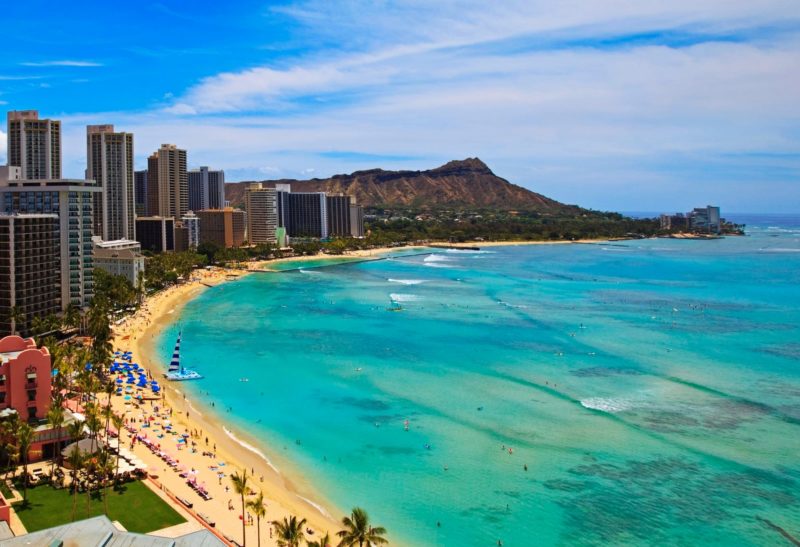
A visit to Honolulu isn’t complete without at least having a look at the Diamond Head crater from Waikiki Beach. Image credit: tomasphoto
Waikīkī, Oʻahu’s main tourist area, is the birthplace of surfing, and the North Shore of the island is a revered surfing paradise, home to the Triple Crown of Surfing and other surfing competitions. The windwardside of Oʻahu is lush and laidback, with long white-sand beaches, hiking trails, and offshore islands. The leeward, or west side, of the island has a string of stunning beaches and local communities.
See our overview of Oʻahu for a more in-depth exploration.
Oʻahu’s Natural Landscape
The island of Oʻahu is made up of two volcanoes, the Waiʻanae Volcano out west and the Koʻolau Volcano in the east.
Being the second-oldest island in the modern-day chain (Kauaʻi is the oldest), Oʻahu shows the beautiful detailing of time and erosion, with jagged peaks along its east coast and several instinct craters on the south shore, including Diamond Head, Punchbowl Crater, and Koko Head Crater. Mt. Kaʻala, the island’s tallest peak, reaches over 4,000 feet on the island’s westside.
Though not as ecologically diverse as the Big Island or Maui (due to the relative lack of elevation), Oʻahu does contain many microclimates and a variety of ecosystems to explore, including wet rainforest, elevated cloud forests, and upcountry agricultural lands.
Having an international city and large areas of urban sprawl on its south shore clouds Oʻahu’s natural abundance in some way, but those visiting the west, east, and north shores will find plenty of natural beauty.
Getting to Oʻahu
Oʻahu is the easiest island to reach thanks to its large international airport in Honolulu (airport code HNL). Though you can fly direct to other islands, Oʻahu offers the most number of routes from the mainland and Asia. Most major mainland and Asian airline carriers offer service to Honolulu, and many connections to the neighbor islands will go through Oʻahu as well.
Because of the number of flights, Oʻahu is also typically the cheapest island to fly into from the mainland, although “cheap” is a relative term when it comes to Hawaiʻi.
See below for pointers on how to get around the island and on how to best travel between several islands.
Getting Around Oʻahu
Because of its big-city infrastructure, Oʻahu has the most extensive transportation network in Hawaiʻi. It features the largest network of roads in the islands, including three interstate highways, as well as an island-wide bus system, partial above-ground train (“the Rail,” as it is called), and plenty of rideshare services.
Rideshare
If staying in Waikīkī or Honolulu, one can rely on rideshare services like Uber and Lyft for short trips around town. These services are available and reliable 24/7 in these areas and are the most efficient and affordable way to get around.
Rental Cars
However, when traveling outside the south shore (Waikīkī/Honolulu), a rental car is your best bet, especially when accessing hiking trails or off-beat beaches. Rental cars give you the flexibility to be on your own schedule and see the island at your own pace.
Public Bus
The bus on Oʻahu, affectionately referred to as “Da Bus,” is a useful option if you
- want the cheapest ride in town, and
- have infinite time.
Short trips through the city will be fine on the bus, with fares costing just a couple dollars, but we advise against longer trips due to the slow, inefficient pace of the bus and the tendency for it to be behind schedule. You can download the bus’s app, Da Bus2 (Google or iPhone), to help navigate the system.
The Rail
The Rail technically exists, but it’s still under construction with only a few stops available, and is not useful at this moment for visitors. Don’t bother.
Trolley
In Waikīkī, there is a hop-on, hop-off trolley that can get you around Waikīkī. Check with the nearest concierge or activities desk to obtain a schedule, or buy tickets online.
Traffic
Though all the Hawaiian Islands experience traffic, Oʻahu is notorious for its congestion, and one would be wise to avoid the road during rush hours, whether it’s in a rental car, bus, or rideshare.
Island Hopping From Oʻahu
Honolulu Airport offers non-stop flights to all neighbor islands via Hawaiian, Southwest, or Mokulele Airlines. Fares typically range from $50 to $100 one-way and are readily available each day, with some routes departing every 1 to 2 hours. Flying is the only way to get from Oʻahu to a neighbor island, so if you decide to island hop, you’ll want to book an inter-island flight.
Booking in advance is always a good idea to assure your seat and to lock in a good price; however, if flexibility is your top priority, Hawaiian Airlines offers enough flights between the major islands that you can *usually* find a seat, even at the last minute. Routes in the morning and evening tend to fill up the fastest, with mid-day flights often less popular.
Definitive guide to island hopping in Hawaiʻi
We walk you through your island-hopping-options, look at the reasons for and against island hopping, and offer some advice on the best way to plan your trip – including money-saving tips and a few suggestion on which islands to pair and why!
Advice for Island Hopping – Visit Oʻahu First
We’ll have more tips for your visit to Oʻahu below, but one important thing we want to relay here concerns island hopping. If your plan is to visit Oʻahu as part of a multi-island trip, we highly suggest visiting Oʻahu first.
Being the busiest island, visiting Oʻahu after you’ve visited a neighbor island can be a shock due to the amount of people and faster pace of life. Start on Oʻahu and then go relax on a neighbor island; doing it the other way around might leave you overwhelmed.
Where to Stay on Oʻahu
Wondering where to stay on Oʻahu? Here are the different regions we recommend.
Waikīkī
The main lodging area on Oʻahu is Waikīkī, a neighborhood of Honolulu. Here you will find the most extensive collection of rooms in all of Hawaiʻi, with dozens of hotel options supplemented by vacation rental options, like Airbnb. No matter where you stay in Waikīkī, you’ll have the option to walk to the beach and to a variety of restaurants, bars, and shops. Room rates here are the cheapest not only on the island, but perhaps in all of Hawaiʻi, due to the quantity available. Waikīkī is a good place to stay for people who value walkability, value, and nightlife, and who want a city-beach environment with lots going on.

Waikiki Beach with Leahi (Diamond Head) in the background. Credit: Hawaii Tourism Authority (HTA) / Vincent Lim
North Shore – Turtle Bay
North Shore accommodations are located in the small resort area of Turtle Bay, where you’ll find Turtle Bay Resort as well as vacation rentals.
The draw here is the local community feel and the long stretch of coast that is extremely popular with surfers in winter and sunbathers in summer. Being up on the North Shore is like being a world away from Honolulu, so folks staying here should be prepared for quiet nights and having the beach/ocean be the top attraction.
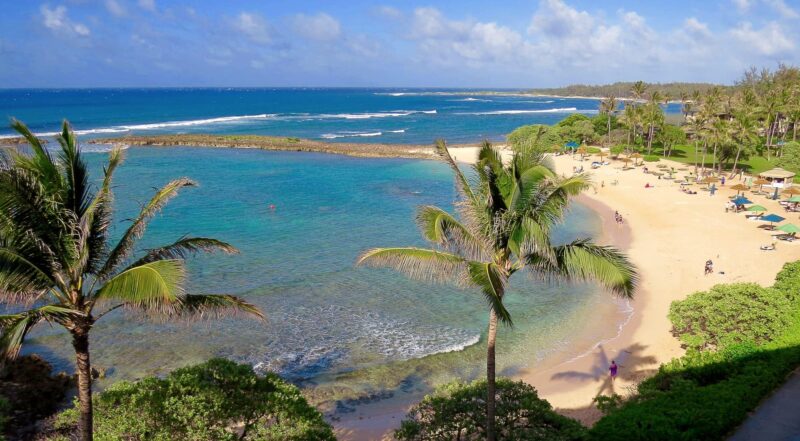
Kuilima Cove as seen from the Turtle Bay Resort. Image credit: Larry Myhre, source.
Note: Swimming on the North Shore during the winter (big wave season) can be treacherous, so waterbugs may want to look elsewhere during those months.
Kailua
The east side of Oʻahu is known for its scenic beauty. Backdropped by the Koʻolau Mountains, the small town of Kailua offers a slow-paced community as compared to Waikīkī. Though the area is not as walkable and things are not open as late, there are plenty of local restaurants and some of the best beaches on the island are located in and around Kailua. The area is good for people looking for a slower pace and who don’t mind driving to get to the beach, restaurants, etc. There aren’t many vacation rentals available in this area anymore, but it’s a great area if you can get one.
Related: how to spend one glorious day in Kailua.
How Long People Stay on Oʻahu
There’s a lot to do on Oʻahu, and if you want to experience everything, we recommend staying for 7 days. However, we realize that many people will have less time, especially if they are visiting multiple islands.
At minimum, we recommend three days on Oʻahu. This amount of time is sufficient to get a good overview of the island and visit some of its major areas and attractions, such as Pearl Harbor, Honolulu/Waikīkī, Kailua, and the North Shore. The highway system makes it easy to get around efficiently, so long as you avoid the standard rush hour times.
For more ideas about how to structure your trip, see our suggested itinerary for Oʻahu:
- Day 1: Waikiki
- Day 2: Honolulu and the South Shore
- Day 3: The West Side
- Day 4: Kailua
- Day 5: Windwardside Road Trip to North Shore
- Day 6: The North Shore
- Day 7: North Shore/Central Oahu
Oʻahu’s Notorious Attractions
Oʻahu combines the modern city with the natural world and thus offers a diversity of attractions not found on the neighbor islands. Below, we list some of the most popular activities, attractions, and areas to visit (in no specific order). Want more ideas? Check out our 14 bite-sized things to do on Oʻahu.
- Pearl Harbor
- Beaches
- Hanauma Bay
- Diamond Head
- Historic sites and museums
- Honolulu Neighborhoods
- Polynesian Cultural Center
- North Shore
- Kualoa Ranch
Pearl Harbor
Site of the Japanese attack in 1941, this national historic site is one of the most visited places in all of Hawaiʻi. We recommend a visit to better understand what happened on this “infamous” day and to learn more about how the attack impacted the local Hawaiian people.
See our complete visitors guide to pearl harbor here and note that it’s best to reserve a ticket for the Arizona Memorial in advance here.
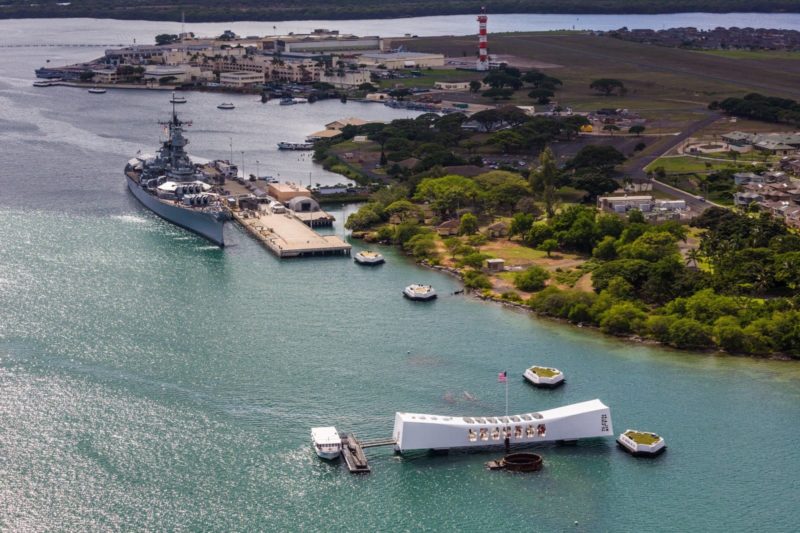
Battleship Missouri and USS Arizona memorials in Pearl Harbor. Credit: Hawaii Tourism Authority (HTA) / Tor Johnson
Beaches
Alongside Maui, Oʻahu boasts some of the best beaches in Hawaiʻi, with many long, white-sand options to choose from. Waikīkī Beach is the birthplace of surfing and the hub of ocean activity, while Kailua Beach and Lanikai Beach offer more tranquility and open space on the east side.
If you’re coming to Hawaiʻi to experience the beach, Oʻahu is a great choice – it’s one of the best islands for beach bums.
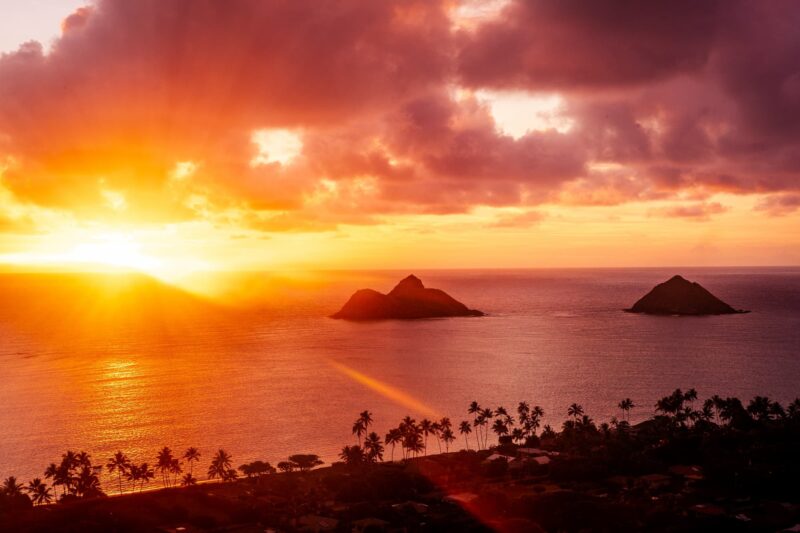
While technically not a sunset, the sunrise as seen from the Lanika Pillboxes on Oʻahu is out of this world. Photo by Amanda Phung on Unsplash
Hanauma Bay
A protected marine sanctuary, Hanauma Bay is the best snorkeling spot on the island for beginners. Featuring calm surf most days, Hanauma Bay is a haven for families, with a safe, sandy beach entrance, a shallow reef, lifeguards, and bathrooms. More advanced snorkeling is available further offshore where the water deepens.
Diamond Head
Diamond Head is perhaps the most recognizable terrain feature in all of Hawaiʻi, its pointed peak serving as the backdrop to Waikīkī Beach in many a postcard. The remnants of an old crater, it is circular in shape and is best experienced via its short-but-steep hiking trail.
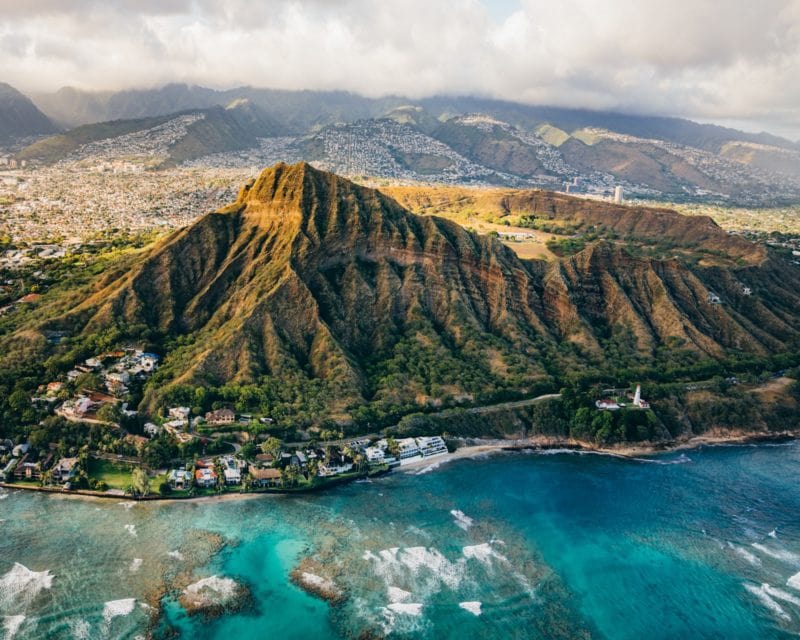
Afternoon shadows on Leahi (aka Diamond Head) with Honolulu spreading our in the background. Credit: Hawaii Tourism Authority (HTA) / Vincent Lim
Historic Sites and Museums
Honolulu is blessed with the best museums in Hawaiʻi, including the Bishop Museum (Hawaiian history, South Pacific migration) and the Honolulu Museum of Art, among others.
It is also home to many historic buildings, leftovers from Hawaiʻi’s days as a monarchy. The ʻIolani Palace is the former royal palace, built in 1882, and other sites, such as the Queen Emma Summer Palace, allows one to explore the island’s royal history more deeply.
See our guide to seeing history and culture on Oʻahu here.
Neighborhoods of Honolulu
Besides Waikīkī, there are many neighborhoods within Honolulu to explore. Kakaʻako, a former industrial area, has undergone lots of change in recent years and is now home to many local apartments, restaurants, breweries, and shops. Downtown Honolulu is home to the main business district and the historic area, while Chinatown offers a variety of markets, restaurants, and late-night bars.
Polynesian Cultural Center
Located in the northeast corner of the island, the Polynesian Cultural Center is a family-friendly attraction that showcases Polynesian history. Owned and run by the Church of Jesus Christ of Latter-Day Saints, the park takes a page out of Epcot’s design and features individual villages representing the various island nations of Polynesia, including Hawaiʻi, Tahiti, Samoa, Fiji, and more. Each village offers interactive exhibits, shows, and games to highlight their unique culture.
The Polynesian Culture Center is best for families with younger children and requires at least a half day to go through.
North Shore
The North Shore of Oʻahu is famous for its surf culture, and one would be remiss to visit Oʻahu and not take a drive along its shores.
In winter, cruise up to watch the professional surfers do their thing at iconic surf breaks like Waimea Bay, Pipeline, or Sunset Beach; In summer, join in on the fun with surf lessons in Haleʻiwa or go for a snorkel at Shark’s Cove. Kayaking or paddleboarding the Anahulu River is a good decision any time of year.
Kualoa Ranch
Nicknamed “Jurassic Valley,” Kualoa Ranch is Oʻahu’s largest hub for adventure-themed tours. From movie tours to horseback riding and ATVs, Kualoa Ranch offers myriad ways to explore its private lands. If you like taking tours, this is the place to go on Oʻahu for its dramatic, beautiful scenery and well-oiled tour operations.
Read more about the top regions in our Overview of Oʻahu.
Visitor Tips
Last but not least, here are some tips for your first trip to Oʻahu:
- Visit Oʻahu first, then head to the neighbor islands… Do NOT do it in reverse. This bears repeating from above. Oʻahu is best experienced first, not last, due to its relatively fast-paced environment and large population.
- Get out of Waikīkī. There’s so much more to Oʻahu than the streets of Waikīkī. We strongly recommend getting out and exploring the island’s more natural side, like the east, west, and north shores.
- Avoid rush hour driving. Enjoy slow mornings on Oʻahu and depart your hotel after 9 a.m. If you leave for the day, come back before 4 p.m. or after 7 p.m. to avoid the worst of the traffic in the Honolulu area.
- Research your restaurants ahead of time. It’s easy to wing it with restaurants on the neighbor islands because, well, there are only so many to choose from. Oʻahu is a different story. There are a lot of great restaurants in the Honolulu area, and Oʻahu is known in the islands for its food scene. So, don’t show up unprepared. Check out local sites like Frolic Hawaiʻi to learn about the latest and greatest food havens.
